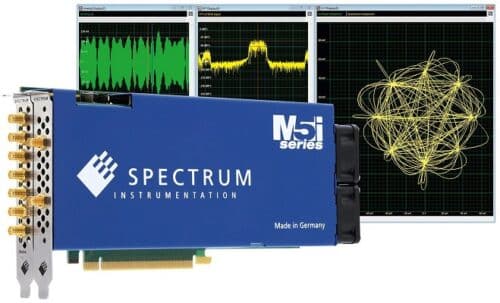The addition of two new PCIe Digitizer cards from Spectrum Instrumentation extends the company’s flagship M5i series to deliver optimal GHz signal acquisition and analysis capabilities. The one and two channel cards offer a stunning combination of ultrafast 10 GS/s sampling speed, with 12-bit vertical resolution, and market-leading 12.8 GB/s data streaming (over the PCIe bus). To achieve the unbeatable streaming rate, they use 16 lane, Gen3, PCIe technology. This allows the acquired data to be sent directly to PC memory for storage, or to CPUs and GPUs for customized signal processing and analysis.
The cards also feature front-end circuitry with over 3 GHz bandwidth and up to 16 GB (8 GSamples) of on-board memory. It all adds up to make these cards a powerful package for engineers and scientists dealing with today’s most challenging GHz-range electronic signals.

With 12-bit resolution, these innovative digitizers offer better dynamic range than most conventional test instruments. For example, they deliver 16 times more resolution than many digital oscilloscopes, which typically use 8-bit analogue to digital converters. The extra resolution allows measurements to be made with better signal to noise ratio (SNR), and improved accuracy and precision. It also lets users capture and characterize fine
signal details that are often missed by lower resolution devices.
The cards are designed to handle a wide variety of signals, such as those found in communications, semiconductor testing, spectroscopy, optical systems and quantum physics. The front-end circuitry has over 3 GHz bandwidth, with programmable full-scale ranges from ±200 mV to ±2.5 V together with variable offset. Acquisitions can be made in
single-shot or multiple-waveform recording modes. Multiple recording divides the on-board memory into segments and allows the acquisition of numerous events, even at very high trigger rates. It is perfect for situations like those encountered in serial bus testing or with devices using stimulus-response processes, such as those found in LIDAR and RADAR systems. For added flexibility, the on-board memory can be used as a ring-buffer, working
much like a conventional oscilloscope, or as a FIFO-buffer for the continuous streaming of data to the PC environment.
To help capture the most elusive signals, a host of trigger modes are available for use on the channel or external trigger inputs. The modes include conventional edge triggering, along with more sophisticated methods such as Window, Re-Arm, Or/And (logical), Software and Delay. Triggering is fast and accurate with waveform data being stored together with its relevant trigger time stamp information. SMA connectors are available on the front panel for the channel inputs, clock and trigger inputs and outputs, as well as four multi-functional digital I/O lines. The extra clock and trigger connections make it possible to synchronize the card with additional digitizers or other measurement devices.
The cards can turn almost any PC it into a powerful measurement tool just by installing them in a suitable PCIe slot. This also opens the door for anyone wishing to use the latest CPU and GPU hardware for signal processing and analysis. The cards come with all the tools necessary to use them in a PC running either a Windows or Linux operating system. A software development kit (SDK) is provided so that the cards can be programmed with almost any popular language. This includes C, C++, C#, Delphi, VB.NET, J#, Python, Julia, Java, LabVIEW, and MATLAB. The SDK contains all the required driver libraries as well as programming examples. Alternatively, for users who do not want to write their own code, the company offers SBench 6 Professional. This powerful measurement software provides full card control, along with a host of data display, analysis, storage, and documentation capabilities.
A key differentiator for all the Spectrum Instrumentation PCIe cards is their capability to stream data directly to and from a CUDA GPU. This is made possible by the company’s SCAPP package (Spectrum’s CUDA Access for Parallel Processing), which is available as a low-cost option. SCAPP includes the drivers for CUDA GPU support and allows users to develop their own processing routines. To help getting started, the package includes working examples that can be modified and built upon. It is ideal for users who need to perform data intensive processing, like continuous averaging for noise reduction, or MPoint-FFTs for spectral analysis.
Another option that is available for the new cards is on-board summation averaging (option M5i.33xx-spavg). Averaging is a very useful tool for reducing unwanted signal noise. At the
same time, it can improve measurement resolution beyond the digitizers standard 12-bit performance, delivering more dynamic range and better SNR. The option uses the cards on-board FPGA (Field Programmable Gate Array) technology to average waveforms, even when they are sampled at the full 10 GS/s. The result is one of the fastest signal averaging solutions on the market, capable of averaging at an astonishing rate of up to 15 million events per second due to the extremely short dead-time of less than 40 ns between events!
Oliver Rovini, Chief Technical Officer, said “These new digitizer cards represent a significant technological step for Spectrum Instrumentation. By offering faster sampling rates and higher bandwidth, we can now address a broader market. For example, we can help more engineers and scientists when they need to acquire and characterize waveforms in the GHz range, or very fast pulses with sub-nanosecond edge speeds. The products are designed to be easy to use and flexible enough to handle almost any signal. It could be a low-level pulse coming from a reflected laser source or high-speed communications signals that involve some sort of sophisticated modulation technique.”
Like all Spectrum Instrumentation products, the new M5i.3350-x16 and M5i.3357-x16 cards carry a 5-year product warranty. They come with customer support, direct from the engineering team, and free software/firmware updates are provided for the whole lifetime of the product. The M5i.33xx series offers 5 different models, with one or two channels, letting you select sampling rates of 3.2, 6.4 or 10 GS/s, and bandwidths of 1, 2 or 3 GHz.






